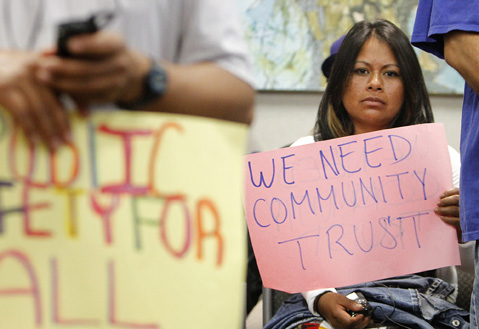ICE Takes Heat on Immigrant Detentions
Feds, Sheriff Field Questions from Santa Barbara Supervisors

Though great pains were taken to discourage people from mentioning the Marilyn Pharis case, the horrific murder of the 64-year-old air force veteran was clearly the reason dozens showed up Tuesday to the Board of Supervisors’ hearing in Santa Maria. Pharis, who lived in Santa Maria, died in the hospital eight days after she was strangled, raped, and beaten with a hammer on July 24. The suspects are two men, one of whom is an undocumented Mexican immigrant who has pleaded not guilty.
Victor Martinez, 29, had been arrested six times, mostly for misdemeanors, in the past 15 months and booked in Santa Barbara County Jail three times before he, along with U.S. citizen Jose Villagomez, who is 20, allegedly acted together to kill Pharis. The case attracted national media attention and generated confusion about the policies in place for undocumented people convicted of crimes. The latter was the purpose of the hearing — called for by Supervisor Steve Lavagnino, who represents Santa Maria — and proved to underscore widely different perceptions of immigration enforcement in Santa Barbara County.
ICE (Immigration and Customs Enforcement) officials have stressed their deportation policies under the one-year-old Priority Enforcement Program (PEP) focus on threats to national security and offenders of violent crimes, particularly felonies. PEP replaced a policy implemented in 2010 known as Secure Communities that cast a net over every undocumented arrestee whether he or she was convicted of a crime or not, ICE official David Marin said Tuesday. Now, ICE officials request county jail staff to hold an inmate longer than their local sentence permits — or notify them of such an inmates’ release date and time — only if the inmate is considered a serious offender.
But a number of reasons make that process complicated. For starters, Sheriff Bill Brown said, the TRUST (Transparency and Responsibility Using State Tools) Act implemented last year indicates law enforcement agencies could be sued if they comply with such ICE detainer requests, and two recent federal court cases reinforced that law. The U.S. Department of Justice and ICE, among others, all agree that “detainers are a request,” Brown said. The exception would be if a judge signed the detainer, he added. But ICE contends no such document exists and that removal cases are not criminal proceedings but are “administrative,” a separate realm of the legal system.
Of the 9,663 people deported in seven Southern California counties in fiscal year 2014, 87 percent were convicted criminals, according to ICE records; figures specific to Santa Barbara County were not immediately available.
In the Martinez case at issue, ICE did not issue a detainer or request to be notified when he would be released because his case history did not show prior significant criminal convictions and he had never been deported, federal officials stated. A week before the Pharis murder, Martinez was arrested for felony possession of a knife and misdemeanor possession of meth and violation of probation. The District Attorney’s Office reduced the knife charge to a misdemeanor, citing the facts presented in the case, and Martinez was released by a judge’s order three days later. He was scheduled to return to County Jail to serve a 30-day sentence on Halloween.
In general, if the Sheriff’s Office notifies ICE exactly when a targeted inmate is expected to be freed, there might not be sufficient time for a federal officer to pick up the inmate. A further wrinkle is that a judge can release an inmate almost immediately, Brown noted. In the past, ICE officials, working out of Santa Maria or Camarillo, have shown up to the County Jail a few hours after a targeted inmate was released, perhaps prompting them to locate the individual in their home or workplace. The jail is not staffed with ICE officials full-time, but ICE agents do go into the jail a few times a week and interview all foreign-born inmates — 13 percent of the current inmate population. Neither ICE nor Sheriff’s officials could say the percentage of foreign-born inmates who are undocumented.
A number of anti-immigration speakers took exception to so-called “sanctuary cities,” which, a few critics noted, Santa Maria is not. “Catch and release might work well for Fish & Game, but it does nothing … for the area,” one speaker said.
On the flipside, many immigrants’ rights advocates — some with CAUSE (Central Coast Alliance United for a Sustainable Economy) — argued a misconception exists that immigrants commit crimes at a higher rate. Nine speakers spoke to the supervisors through a translator, describing fear that exists among the undocumented community about authorities, sometimes deterring undocumented people from ever going to the police for help.
“Trust is important,” Brown said. “We are not interested in seeing … hard-working people face deportation.” Brown also called for comprehensive immigration reform, expressing frustration at the discrepancy between federal and state laws. Many speakers and Supervisor Janet Wolf, who has been publically critical of Brown, lauded the sheriff for acting fairly toward undocumented residents.
No action was taken Tuesday, but Lavagnino vowed to work with ICE officials to clarify data, including the number of undocumented people in the County Jail and the number of ICE priority individuals who are on the streets.



